Poison Dart Frog (original) (raw)
Poison Dart Frog Pictures
View all of our Poison Dart Frog pictures in the gallery.

View all of the Poison Dart Frog images!
Share on:
Poison dart frogs are a tiny species of frog that lives in Central and South America.
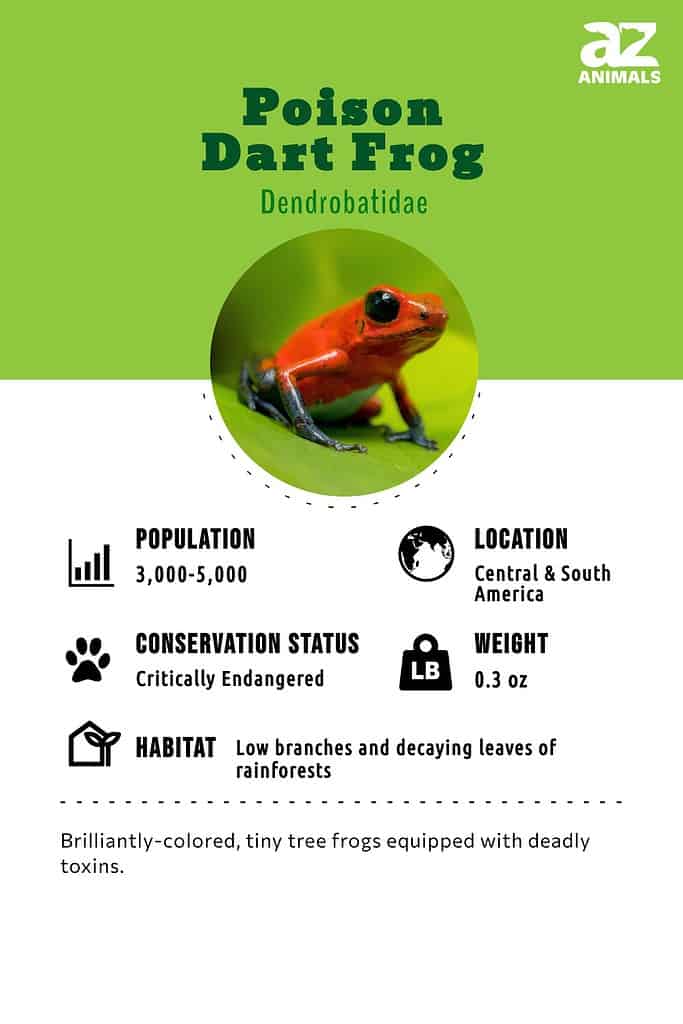
One of their main adaptations to keep them safe from predators is their brightly colored skin, which ranges from yellow to bright blue or red. This skin warns predators looking to add them to their diet that these tiny frogs are extremely toxic if ingested.
5 Incredible Poison Dart Frog Facts!
- A group of poison dart frogs is known as an “army.”
- One of this frog’s adaptations is its brightly colored body, from blue to red and black to golden yellow.
- Poison dart frogs are sometimes known as “poison arrow frogs.”
- The golden poison dart frog, the most toxic of all of the frog species, has enough toxin in its body to kill over 20,000 mice.
- Some varieties of these frog’s poison show promise in the medical field, including one being synthetically adapted to be a painkiller for humans.
Scientific Name
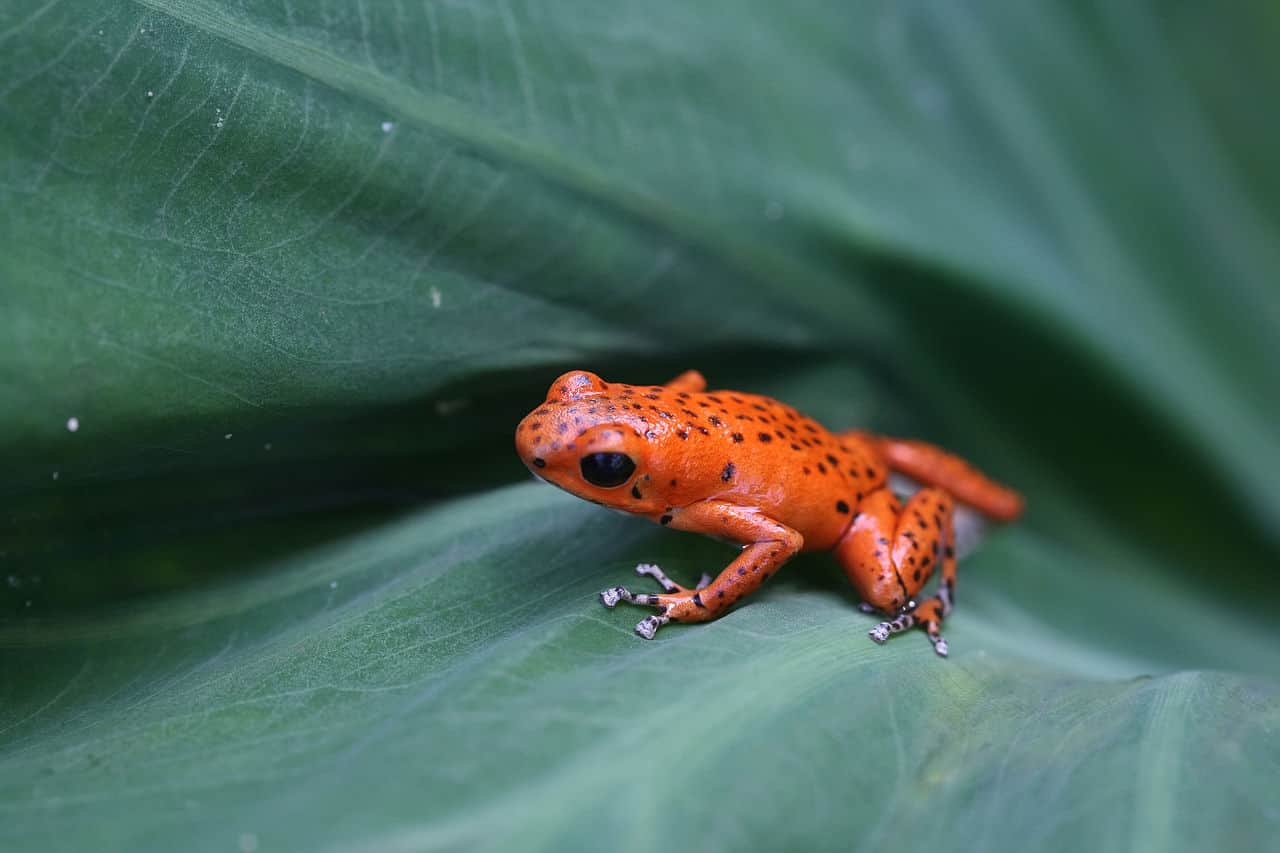
Poison dart frogs are members of the
Dendrobatidae
family.
©Splette / CC BY-SA 3.0 – Original / License
These frogs belong to a wide array of genera and species, with many different scientific names. There are over 175 known species. However, all belong to the family Dendrobatidae. This scientific name is formed from the Greek word for tree, dendro, which is also used in the word dendrology, the study of trees. Batēs is the Greek word meaning “one that treads.” Therefore, the family name Dendrobatidae means “one that reads in trees,” or simply “tree climber.”
Appearance
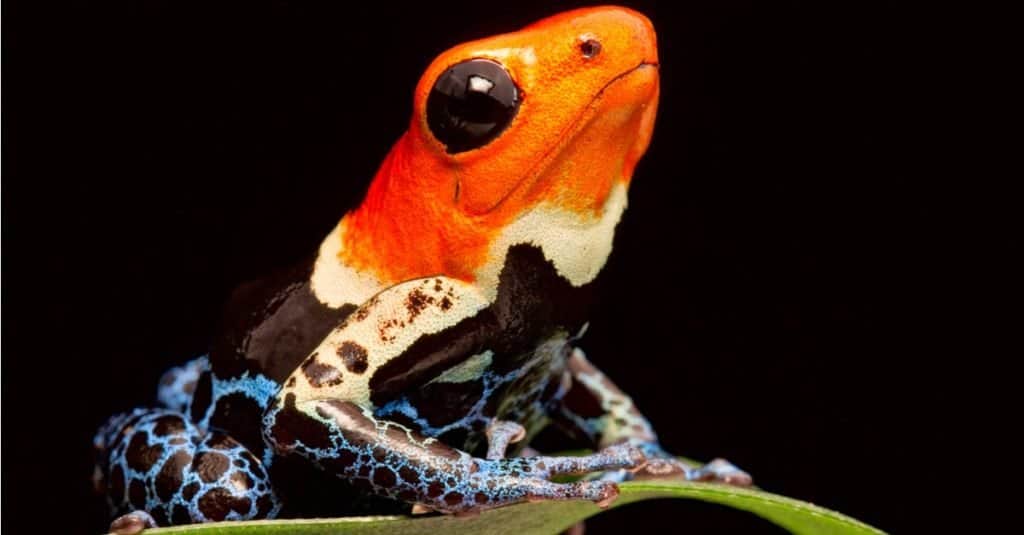
Poison dart frogs have gorgeous colors and patterns on their skin.
©Dirk Ercken/Shutterstock.com
One of the adaptations these frogs are famous for is their brightly colored skin. This skin serves as a warning to predators about their extremely toxic secretions. The term for creatures that have bright coloration to warn predators that they are toxic is called “aposematic coloration.”
The different species come in a rainbow of colors, including blue, yellow, red, green, golden, and black. The strawberry poison dart frog is one of the species’ most poisonous members and has a bright red body with blue legs. The golden poison dart frog is also especially dangerous and has enough toxins to kill over 20,000 mice. It is also the largest of the poison dart frog species.
However, the facts are that not all members of the poison dart frog family are poisonous, or brightly colored. Some humble species come in shades of tan and brown, and these species are usually not toxic to most animals.
These frogs tend to be small, with the average length being around 1 inch. Like most frog species, their skin is smooth and damp, and they have webbed toes.
Evolution
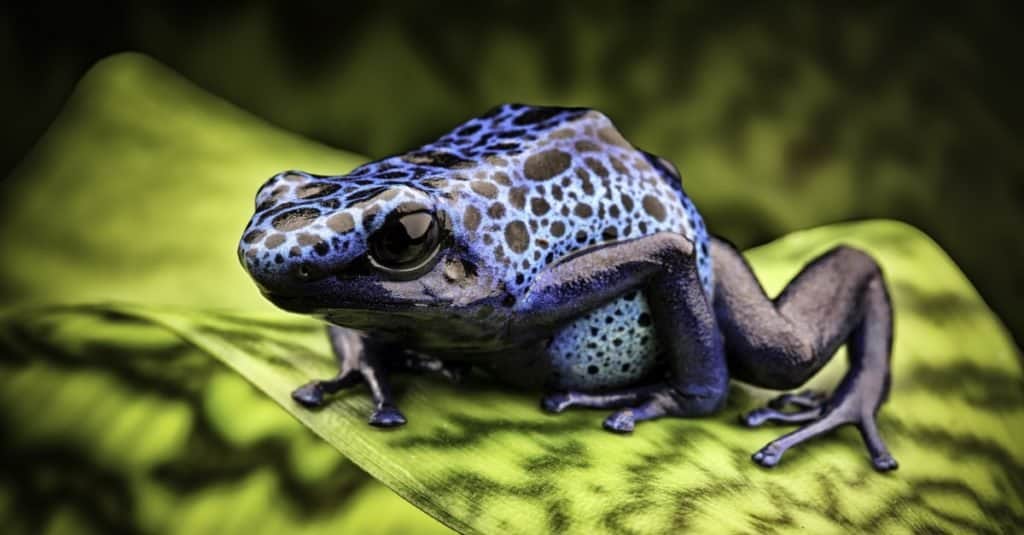
Their life-threatening toxins and picturesque patterns are the most notable traits poison dart frogs have adapted.
©Dirk Ercken/Shutterstock.com
It is believed that Poison dart frogs first began to express their trademark mutations and evolve from their non-poisonous relatives sometime 20-40 Million years ago. In addition to developing a powerful toxicity and their striking warning colors, these amphibians also had to acquire a resistance to their own poison in order to survive, an evolutionary hurdle that all poisonous creatures must overcome. Poison dart frogs achieved this through the genetic manipulation of a single amino acid in their DNA.
The vast array of species and genera, all displaying their own unique color variants indicate a high level of genetic diversity in these amphibians, with scientist believing some new species first emerged as recently as 6,000 years ago.
Behavior
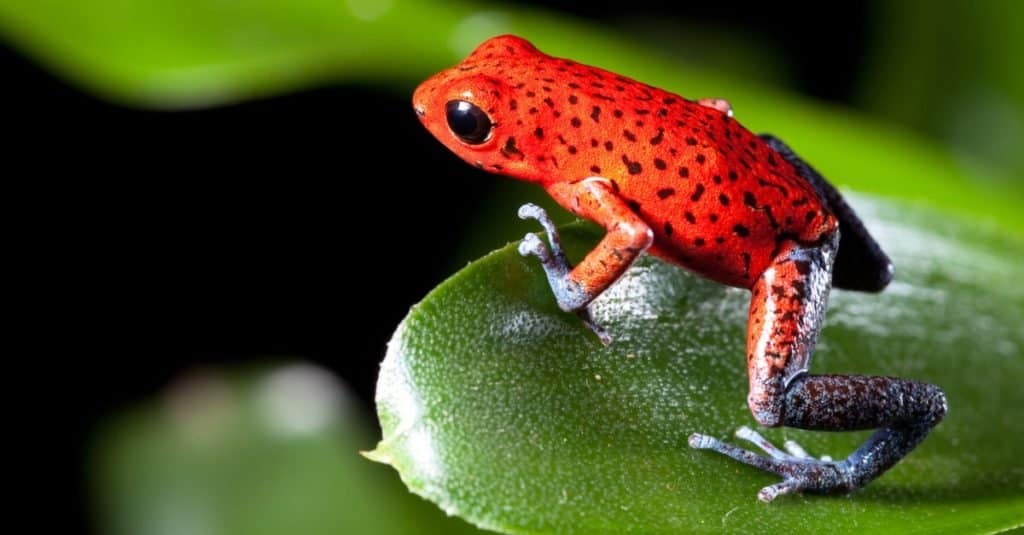
Poison dart frogs use their vibrant colors as a warning of the deadly toxins within them.
©Dirk Ercken/Shutterstock.com
Some facts about these frogs’ behavior include that they like to live in the trees closest to the ground, or the leaf litter of the jungle floor. They prefer resting on leaves and tree branches.
These frogs croak and squeak like other frog species, using these calls to establish their habitats and attract mates. They are mostly diurnal creatures, which means they are active during the day.
These frogs make little attempt to hide from predators, as their skin is warning enough. If their toxins don’t kill a predator, they will at least make them very unappetizing. Predators will remember the unpleasant taste of this frog, and will likely not attempt to eat another one again.
Habitat
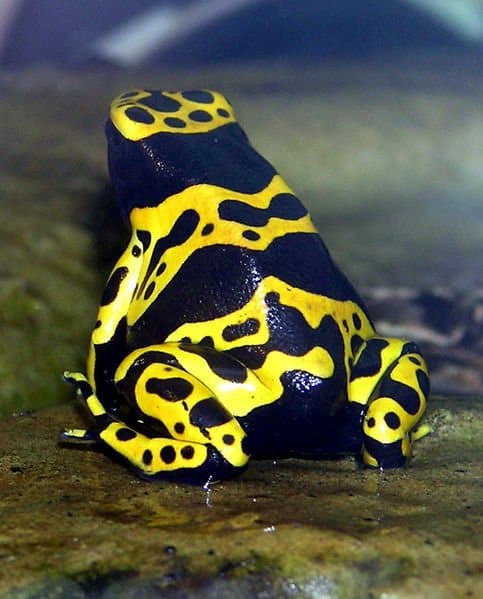
Many Poison Dart Frogs are endemic to the Amazon rainforest.
©Arpingstone, Public domain, via Wikimedia Commons – Original / License
These frogs are native to the damp rainforests of Central and South America. They can sometimes be confused with another small, brightly colored frog species called the Mantella, but Mantellas are only native to Madagascar.
These frogs have also been introduced to Hawaii. They used to be imported to the US in great numbers for the pet trade, but this has since slowed down. In Europe, some species of frogs are smuggled into the country.
Because of their sensitivity to the environment, these frogs do not do well in heavily polluted areas.
Diet
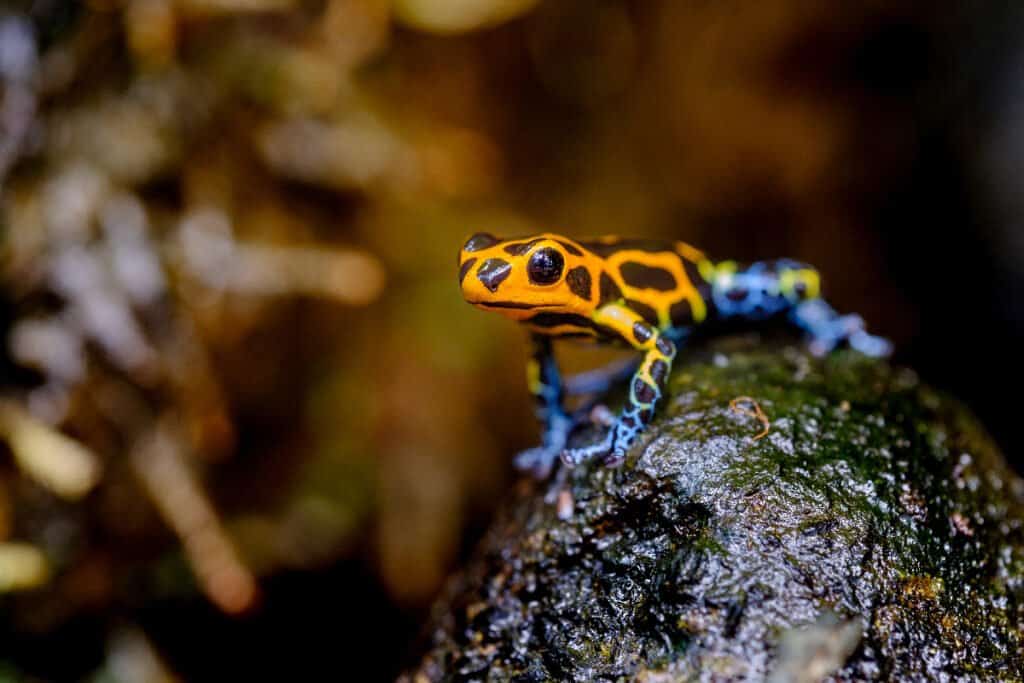
Poison dart frogs primarily eat small insects.
©Frank Cornelissen/Shutterstock.com
These frogs use their long, sticky tongue to capture insects. This diet makes the frog a carnivore. Their diet consists of termites, flies, ants, and many other species of insects, which are plentiful in the habitat where poison dart frogs live.
Tadpoles can be omnivorous and sometimes eat algae. They are also sometimes fed unfertilized eggs from their parents. Some species of frogs are even cannibals and eat the tadpoles of other species.
It is thought that the diet of the poison dart frog is responsible for its toxicity. Scientists are unsure which of the insects the frogs eat make them toxic. However, frogs raised in captivity and fed crickets and fruit flies do not release toxins from their skin.
Predators and Threats
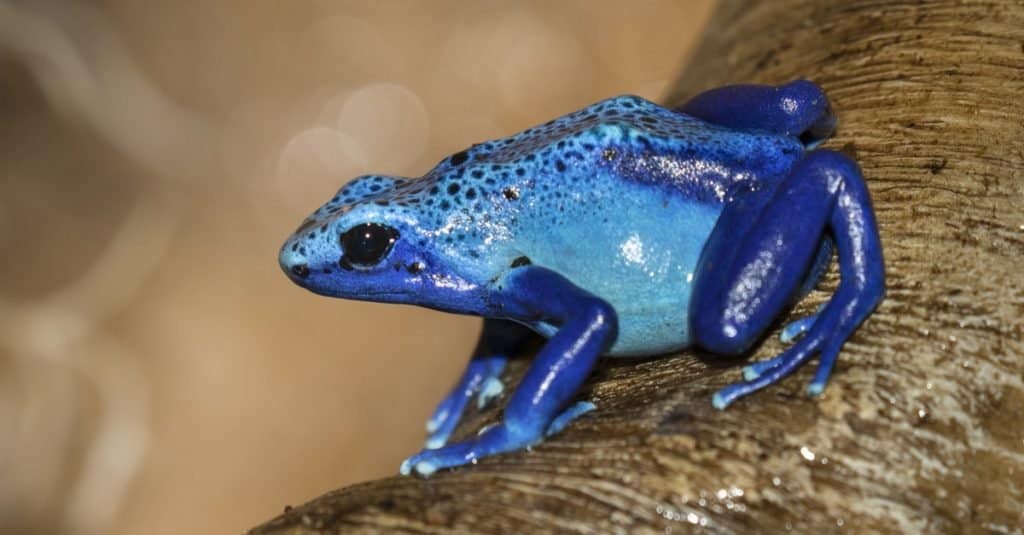
Poison Dart Frogs are constantly threatened with habitat loss due to deforestation.
©Natalia Kuzmina/Shutterstock.com
Because the toxins in their skin make them unpleasant or even toxic for most animals to eat, poison dart frogs do not have a wide array of natural predators. There is a species of snake, Leimadophis epinephelus that is immune to the venom of the poison dart frog.
Frog species, including the poison dart frog, sometimes fall victim to the chytrid fungus. This disease is a type of infective fungus that causes lethargy, weight loss, and eventually death. It is highly contagious and threatens over 100 different frog species.
Many species of poison dart frog are listed as endangered or critically endangered due to habitat loss and pollution. Large swathes of rainforest are often burned to make room for farmland as well as deforested for lumber. Some species are also captured and exported for the pet trade.
Reproduction, Babies, and Lifespan
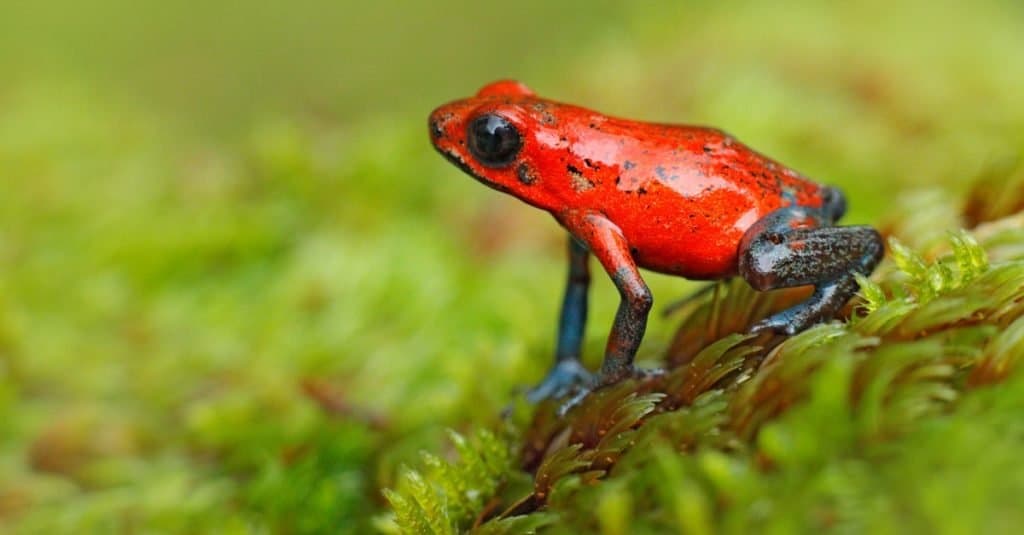
Poison dart frogs emit fascinating sounds during their mating seasons.
©Ondrej Prosicky/Shutterstock.com
Poison dart frogs breed multiple times throughout the year, often in conjunction with periods of rainfall. Both males and females are combative during this time – males compete for ideal perches from which to call for mates, and females compete for nesting areas. Females are sometimes known to devour the eggs of other frogs.
The mating process occurs once the male has performed his mating call and located a female with which to breed. The male lures the female to a place where he would like to mate using an elaborate courtship ceremony. This courtship consists of wrestling, stroking, and leading the female around. The ceremony can last many hours before the two decide to settle, and the female can lay her eggs.
Females will deposit their eggs in the moist leaf litter. The amount of eggs varies from 1 egg to 40 eggs, with the average being about ten eggs per clutch. The male will then fertilize the eggs once the female has lain. Both parents will guard the eggs, taking care to make sure they do not dry out.
Once the young tadpoles hatch, about 10 to 18 days after the eggs have been fertilized, the parents will carry the tadpoles on their backs. When the parent frog sits in the cluster of young tadpoles, they can squirm their way onto the parents’ back. The parents carry their young, either all at once or a few at a time, to small pools where they can grow and mature. Tadpoles will grow into adult frogs after many months. In this young form, they are exceptionally vulnerable to predators.
The lifespan of the poison dart frog is not well-researched. In the wild, some scientists say they live as few as three years. In captivity, it is reported that some species can live to be up to 25 years old.
Population
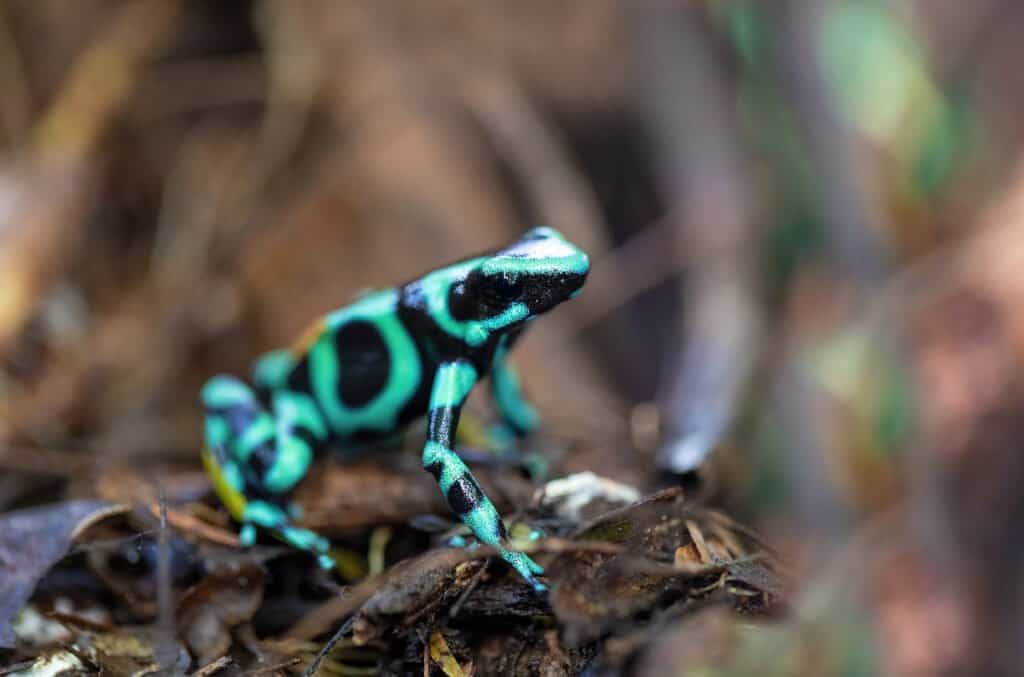
Many species of poison dart frogs are critically endangered.
©iStock.com/Artush
Poison dart frogs, like many other species native to the rainforests of South America, are in population decline. Some species are endangered or critically endangered due to habitat loss, climate change, and fungal disease. Because of the number of species as well as their remote location, it is not possible to get accurate measurements of population data.
Poison Dart Frogs In the Zoo
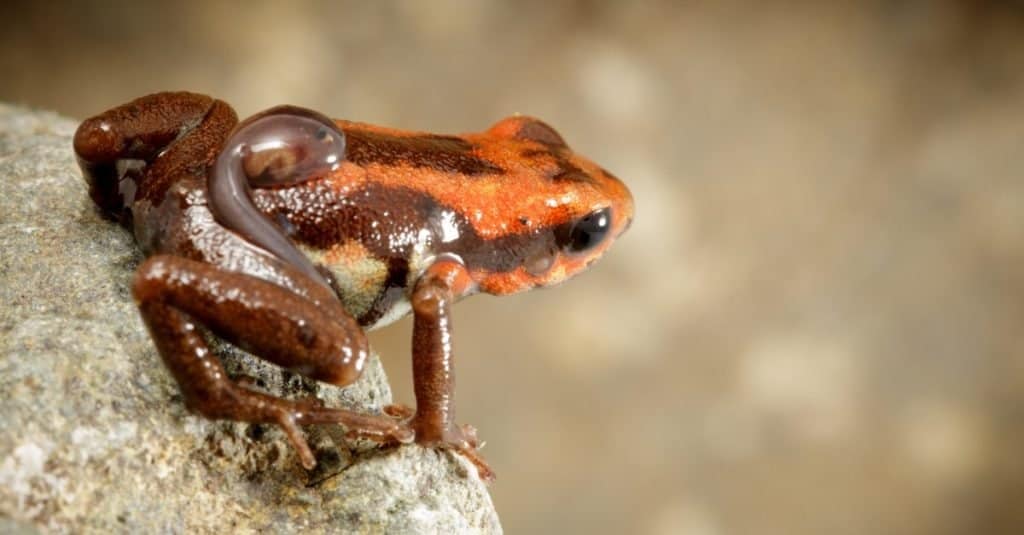
Many zoos have exhibits where you can safely encounter poison dart frogs.
©Dirk Ercken/Shutterstock.com
These frogs are a common attraction in zoos and aquariums everywhere. The San Diego Zoo and the Smithsonian both have captive poison dart frogs, as well as Reid Park Zoo and the Seneca Park Zoo.
In zoos, these frogs are fed insects that do not cause them to develop toxins in their skin. They are fed insects like these because they frequently need to be handled by zookeepers and vets while in captivity.
Types of Poison Dart Frog
There are over 300 different species of poison dart frogs, you can find a comprehensive list of every kind below:
| Montane Rocket Frog | _Allobates alessandroi |
|---|---|
| Spotted Nurse Frog | _Allobates algorei |
| (No common name) | Allobates amissibilis |
| (No common name) | Allobates bacurau |
| Coastal Rocket Frog | Allobates bromelicola |
| Chupada Rocket Frog | Allobates brunneus |
| (No common name) | Allobates caeruleodactylus |
| (No common name) | Allobates caribe |
| (No common name) | Allobates cepedai |
| Martinique Volcano Frog | Allobates chalcopis |
| (No common name) | Allobates conspicuous |
| (No common name) | Allobates crombiei |
| Brilliant-thighed Poison Frog | Allobates femoralis |
| Yellow-bellied Stream Frog | Allobates flaviventris |
| Rana Saltarina de Mera | Allobates fratisenescus |
| (No common name) | Allobates fuscellus |
| (No common name) | Allobates gasconi |
| Goias Rocket Frog | Allobates goianus |
| Black-flanked Poison Frog | Allobates granti |
| (No common name) | Allobates grillicantus |
| (No common name) | Allobates grillisimilis |
| (No common name) | Allobates hodli |
| Bocono Rocket Frog | Allobates humilis |
| Nurse Frog Of The Serranía De Perijá | Allobates ignotus |
| Rana Saltarina de Santa Cecilia | Allobates insperatus |
| Juami River Rocket Frog | Allobates juami |
| (No common name) | Allobates juanii |
| ****(No common name)** | Allobates kamilae |
| Kingsbury’s Rocket Frog | Allobates kingsburyi |
| ****(No common name)** | Allobates magnussoni |
| Mount Turumiquire Rocket Frog | Allobates mandelorum |
| Dull Rocket Frog | Allobates marchesianus |
| ****(No common name)** | Allobates masniger |
| Mcdiarmid’s Rocket Frog | Allobates mcdiarmidi |
| ****(No common name)** | Allobates melanolaemus |
| Myers’ Poison Frog | Allobates myersi |
| ****(No common name)** | Allobates nidicola |
| ****(No common name)** | Allobates niputidea |
| ****(No common name)** | Allobates nunciatus |
| Rio Rocket Frog | Allobates olfersioides |
| ****(No common name)** | Allobates ornatus |
| ****(No common name)** | Allobates pacaas |
| ****(No common name)** | Allobates paleci |
| Amazonian Nurse Frog | Allobates paleovarzensis |
| ****(No common name)** | Allobates picachos |
| (No common name) | Allobates pittieri |
| Llanos Rocket Frog | Allobates ranoides |
| San Martin Rocket Frog | Allobates sanmartini |
| (No common name) | Allobates sieggreenae |
| (No common name) | Allobates subfolionidificans |
| (No common name) | Allobates sumtuosus |
| Striped Rocket Frog | Allobates talamancae |
| (No common name) | Allobates tapajos |
| (No common name) | Allobates tinae |
| Three-striped Rocket Frog | Allobates trilineatus |
| (No common name) | Allobates undulatus |
| (No common name) | Allobates vanzolinius |
| Fast Singer Frog | Allobates velocicantus |
| Colostethus Wayuu | Allobates wayuu |
| Zaparo’s Poison Frog | Allobates zaparo |
| (No common name) | Anomaloglossus apiau |
| (No common name) | Anomaloglossus ayarzaguenai |
| (No common name) | Anomaloglossus baeobatrachus |
| Beebe’s Rocket Frog | Anomaloglossus beebei |
| (No common name) | Anomaloglossus blanci |
| (No common name) | Anomaloglossus breweri |
| Degranville’s Rocket Frog | Anomaloglossus degranvillei |
| (No common name) | Anomaloglossus dewynteri |
| (No common name) | Anomaloglossus guanayensis |
| Kaie Rock Frog | Anomaloglossus kaiei |
| Leopard Rocket Frog | Anomaloglossus leopardus |
| (No common name) | Anomaloglossus meansi |
| (No common name) | Anomaloglossus mitaraka |
| Sarisariñama Rocket Frog | Anomaloglossus moffetti |
| (No common name) | Anomaloglossus murisipanensis |
| (No common name) | Anomaloglossus parimae |
| (No common name) | Anomaloglossus parkerae |
| (No common name) | Anomaloglossus praderioi |
| Roraima Rocket Frog | Anomaloglossus roraima |
| Chimantá Poison Frog | Anomaloglossus rufulus |
| (No common name) | Anomaloglossus saramaka |
| Shreve’s Rocket Frog | Anomaloglossus shrevei |
| Stephen’s Rocket Frog | Anomaloglossus stepheni |
| Suriname Rock Frog | Anomaloglossus surinamensis |
| (No common name) | Anomaloglossus tamacuarensis |
| (No common name) | Anomaloglossus tepequem |
| (No common name) | Anomaloglossus tepuyensis |
| (No common name) | Anomaloglossus triunfo |
| (No common name) | Anomaloglossus vacheri |
| (No common name) | Anomaloglossus verbeeksnyderorum |
| (No common name) | Anomaloglossus wothuja |
| Whitebelly Rocket Frog | Aromobates alboguttatus |
| (No common name) | Aromobates cannatellai |
| Sierra Nevada Rocket Frog | Aromobates capurinensis |
| Durant’s Rocket Frog | Aromobates duranti |
| (No common name) | Aromobates ericksonae |
| El Vivero Rocket Frog | Aromobates haydeeae |
| (No common name) | Aromobates inflexus |
| Leopard Rocket Frog | Aromobates leopardalis |
| Mayorga Rocket Frog | Aromobates mayorgai |
| Merida Rocket Frog | Aromobates meridensis |
| Las Playitas Rocket Frog | Aromobates molinarii |
| Venezuelan Skunk Frog | Aromobates nocturnus |
| Ornate Cloud Frog | Aromobates ornatissimus |
| Tachira Rocket Frog | Aromobates orostoma |
| Salty Rocket Frog | Aromobates saltuensis |
| Pefaur’s Rocket Frog | Aromobates serranus |
| Perija’s Nurse Frog | Aromobates tokuko |
| **Piñango Rocket Frog | Aromobates walterarpi |
| (No common name) | Aromobates zippeli |
| (No common name) | Mannophryne caquetio |
| Collared Poison Frog | Mannophryne collaris |
| (No common name) | Mannophryne cordilleriana |
| Hermina’s Poison Frog | Mannophryne herminae |
| (No common name) | Mannophryne lamarcai |
| (No common name) | Mannophryne larandina |
| (No common name) | Mannophryne leonardoi |
| (No common name) | Mannophryne molinai |
| Aragua Poison Frog | Mannophryne neblina |
| St. Teresa Poison Frog | Mannophryne oblitterata |
| Bloody Bay Poison Frog | Mannophryne olmonae |
| Orellana’s Collared Frog | Mannophryne orellana |
| Rivero’s Poison Frog | Mannophryne riveroi |
| (No common name) | Mannophryne speeri |
| Trinidad Poison Frog | Mannophryne trinitatis |
| (No common name) | Mannophryne trujillensis |
| Urticant Collared Frog | Mannophryne urticans |
| (No common name) | Mannophryne venezuelensis |
| Caracas Collared Frog | Mannophryne vulcano |
| Yacambu Poison Frog | Mannophryne yustizi |
| Palm Rocket Frog | Rheobates palmatus |
| (No common name) | Rheobates pseudopalmatus |
| Tarapoto Poison Frog | Ameerega altamazonica |
| La Planada Poison Frog | Ameerega andina |
| Pleasing Poison Frog | Ameerega bassleri |
| (No common name) | Ameerega berohoka |
| Ecuador Poison Frog | Ameerega bilinguis |
| (No common name) | Ameerega boehmei |
| Bolivian Poison Frog | Ameerega boliviana |
| (No common name) | Ameerega braccata |
| Cainarachi Poison Frog | Ameerega cainarachi |
| Palenque Poison Frog | Ameerega erythromos |
| Yellow-spotted Frog | Ameerega flavopicta |
| (No common name) | Ameerega hahneli |
| (No common name) | Ameerega ignipedis |
| Riddle Poison Frog | Ameerega imasmari |
| Niceforo’s Poison Frog | Ameerega ingeri |
| (No common name) | Ameerega labialis |
| Manu Poison Frog | Ameerega macero |
| Confusing Poison Frog | Ameerega maculata |
| (No common name) | Ameerega munduruku |
| Panguana Poison Frog | Ameerega panguana |
| Ruby Poison-arrow Frog | Ameerega parvula |
| (No common name) | Ameerega pepperi |
| (No common name) | Ameerega peruviridis |
| Peru Poison Frog | Ameerega petersi |
| Spot-legged Poison Frog | Ameerega picta |
| Oxapampa Poison Frog | Ameerega planipaleae |
| (No common name) | Ameerega pongoensis |
| (No common name) | Ameerega pulchripecta |
| (No common name) | Ameerega rubriventris |
| **Amarakaeri poison frog | Ameerega shihuemoy |
| Silverstone’s Poison Frog | Ameerega silverstonei |
| (No common name) | Ameerega simulans |
| Three-striped Poison Frog | Ameerega trivittata |
| (No common name) | Ameerega yoshina |
| (No common name) | Ameerega yungicola |
| Cauca Rocket Frog | Colostethus agilis |
| Finca Primavera Rocket Frog | Colostethus alacris |
| Stripe-throated Rocket Frog | Colostethus brachistriatus |
| (No common name) | Colostethus dunni |
| (No common name) | Colostethus dysprosium |
| Santa Rita Rocket Frog | Colostethus fraterdanieli |
| (No common name) | Colostethus furviventris |
| Silverstone’s Rocket Frog | Colostethus imbricolus |
| Common Rocket Frog | Colostethus inguinalis |
| Truando Rocket Frog | Colostethus latinasus |
| (No common name) | Colostethus lynchi |
| Mertens’ Rocket Frog | Colostethus mertensi |
| Panama Rocket Frog | Colostethus panamansis |
| Amazonas Rocket Frog | Colostethus poecilonotus |
| Pratt’s Rocket Frog | Colostethus pratti |
| (No common name) | Colostethus ramirezi |
| (No common name) | Colostethus ruthveni |
| Thornton’s Rocket Frog | Colostethus thorntoni |
| (No common name) | Colostethus ucumari |
| (No common name) | Colostethus yaguara |
| Anthony’s Poison Arrow Frog | Epipedobates anthonyi |
| Rana Nodriza de Boulenger | Epipedobates boulengeri |
| Rana Nodriza de Darwin y Wallace | Epipedobates darwinwallacei |
| Rana Nodriza de Espinosa | Epipedobates espinosai |
| (No common name) | Epipedobates machalilla |
| Narino Poison Frog | Epipedobates narinensis |
| Phantasmal Poison Frog | Epipedobates tricolor |
| Imaza Rocket Frog | Leucostethus argyrogaster |
| Rana Pecho Blanco de Bilsa | Leucostethus bilsa |
| Rana Cohete de Pastaza | Leucostethus fugax |
| (No common name) | Leucostethus jota |
| (No common name) | Leucostethus siapida |
| (No common name) | Silverstoneia dalyi |
| (No common name) | Silverstoneia erasmios |
| Rainforest Rocket Frog | Silverstoneia flotator |
| (No common name) | Silverstoneia gutturalis |
| (No common name) | Silverstoneia minima |
| (No common name) | Silverstoneia minutissima |
| Boquete Rocket Frog | Silverstoneia nubicola |
| (No common name) | Silverstoneia punctiventris |
| Brazil-Nut Poison Frog | Adelphobates castaneoticus |
| Splash-Backed Poison Frog | Adelphobates galactonotus |
| Rio Madeira Poison Frog | Adelphobates quinquevittatus |
| Collins’ Poison Frog | Andinobates abditus |
| Alto De Buey Poison Frog | Andinobates altobueyensis |
| Cauca Poison Frog | Andinobates bombetes |
| Cassidy’s Poison Dart Frog | Andinobates cassidyhornae |
| (No common name) | Andinobates claudiae |
| (No common name) | Andinobates daleswansoni |
| (No common name) | Andinobates dorisswansonae |
| Yellowbelly Poison Frog | Andinobates fulguritus |
| Geminis’ Dart Frog | Andinobates geminisae |
| Bluebelly Poison Frog | Andinobates minutus |
| Andean Poison Frog | Andinobates opisthomelas |
| Supatá Golden Poison Frog | Andinobates supata |
| (No common name) | Andinobates tolimensis |
| (No common name) | Andinobates victimatus |
| Green Poison Frog | Andinobates viridis |
| Santander Poison Frog | Andinobates virolinensis |
| Gold Arrow-Poison Frog | Dendrobates auratus |
| Yellow-banded Poison Frog | Dendrobates leucomelas |
| (No common name) | Dendrobates nubeculosus |
| Tinging Frog | Dendrobates tinctorius |
| Yellow-striped Poison Frog | Dendrobates truncatus |
| Rio Santiago Poison Frog | Excidobates captivus |
| Condor Poison Frog | Excidobates condor |
| Marañón Poison Frog | Excidobates mysteriosus |
| Demonic Poison Frog | Minyobates steyermarki |
| (No common name) | Oophaga anchicayensis |
| (No common name) | Oophaga andresi |
| Polkadot Poison Frog | Oophaga arborea |
| Granular Poison Frog | Oophaga granulifera |
| Harlequin Poison Frog | Oophaga histrionica |
| Lehmann’s Poison Frog | Oophaga lehmanni |
| La Brea Poison Frog | Oophaga occultator |
| Strawberry Poison Frog | Oophaga pumilio |
| (No common name) | Oophaga solanensis |
| Splendid Poison Frog | Oophaga speciosa |
| Little-devil Poison Frog | Oophaga sylvatica |
| Vicente’s Poison Frog | Oophaga vicentei |
| Kokoe Poison Frog | Phyllobates aurotaenia |
| Two-Toned Arrow-Poison Frog | Phyllobates bicolor |
| Lovely Poison Frog | Phyllobates lugubris |
| Golden Poison Frog | Phyllobates terribilis |
| Golfodulcean Poison Frog | Phyllobates vittatus |
| (No common name) | Ranitomeya amazonica |
| (No common name) | Ranitomeya benedicta |
| (No common name) | Ranitomeya cyanovittata |
| (No common name) | Ranitomeya defleri |
| Red-Headed Poison Frog | Ranitomeya fantastica |
| (No common name) | Ranitomeya flavovittata |
| Mimic Poison Frog | Ranitomeya imitator |
| Red-Backed Poison Frog | Ranitomeya reticulata |
| Sira Poison Frog | Ranitomeya sirensis |
| (No common name) | Ranitomeya summersi |
| (No common name) | Ranitomeya toraro |
| (No common name) | Ranitomeya uakarii |
| Brazillian Poison Frog | Ranitomeya vanzolinii |
| Zimmermann’s Poison Frog | Ranitomeya variabilis |
| Amazonian Poison Frog | Ranitomeya ventrimaculata |
| (No common name) | Ranitomeya yavaricola |
| (No common name) | Ectopoglossus absconditus |
| (No common name) | Ectopoglossus astralogaster |
| (No common name) | Ectopoglossus atopoglossus |
| Rana Nodriza Confusa | Ectopoglossus confusus |
| (No common name) | Ectopoglossus isthminus |
| (No common name) | Ectopoglossus lacrimosus |
| (No common name) | Ectopoglossus saxatilis |
| Bello Rocket Frog | Hyloxalus abditaurantius |
| (No common name) | Hyloxalus aeruginosus |
| South American Rocket Frog | Hyloxalus anthracinus |
| (No common name) | Hyloxalus arliensis |
| Awa Rocket Frog | Hyloxalus awa |
| Sky-Blue Poison Frog | Hyloxalus azureiventris |
| (No common name) | Hyloxalus betancuri |
| Bocage’s Rocket Frog | Hyloxalus bocagei |
| (No common name) | Hyloxalus borjai |
| Urrao Rocket Frog | Hyloxalus breviquartus |
| Palanda Rocket Frog | Hyloxalus cevallosi |
| (No common name) | Hyloxalus chlorocraspedus |
| Choco Rocket Frog | Hyloxalus chocoensis |
| (No common name) | Hyloxalus craspedoceps |
| Rana Cohete de Stella | Hyloxalus delatorreae |
| Edwards’ Rocket Frog | Hyloxalus edwardsi |
| Loja Rocket Frog | Hyloxalus elachyhistus |
| (No common name) | Hyloxalus eleutherodactylus |
| Yapitya Rocket Frog | Hyloxalus exasperatus |
| (No common name) | Hyloxalus excisus |
| Puerto Narino Rocket Frog | Hyloxalus faciopunctulatus |
| Cotopaxi Rocket Frog | Hyloxalus fallax |
| (No common name) | Hyloxalus fascianigrus |
| (No common name) | Hyloxalus felixcoperari |
| Quijos Rocket Frog | Hyloxalus fuliginosus |
| Rivero’s Rocket Frog | Hyloxalus idiomelus |
| Chimbo Rocket Frog | Hyloxalus infraguttatus |
| (No common name) | Hyloxalus insulatus |
| Rana Cohete de Pastaza | Hyloxalus italoi |
| Rana Cohete de Quito | Hyloxalus jacobuspetersi |
| (No common name) | Hyloxalus jhoncito |
| Lehmann’s Rocket Frog | Hyloxalus lehmanni |
| (No common name) | Hyloxalus leucophaeus |
| Little Rocket Frog | Hyloxalus littoralis |
| Spotted Rocket Frog | Hyloxalus maculosus |
| Rana Cohete Maquipucuna | Hyloxalus maquipucuna |
| Rio Negro Rocket Frog | Hyloxalus marmoreoventris |
| Mittermeier’s Rocket Frog | Hyloxalus mittermeieri |
| Cloud Forest Rocket Frog | Hyloxalus mystax |
| Los Tayos Rocket Frog | Hyloxalus nexipus |
| Gualaceo Rocket Frog | Hyloxalus parcus |
| (No common name) | Hyloxalus patitae |
| Funny Rocket Frog | Hyloxalus peculiaris |
| Peru Rocket Frog | Hyloxalus peruvianus |
| Malvasa Rocket Frog | Hyloxalus pinguis |
| Espada’s Rocket Frog | Hyloxalus pulchellus |
| San Vicente Rocket Frog | Hyloxalus pumilus |
| Ramos’ Rocket Frog | Hyloxalus ramosi |
| Ruiz’s Rocket Frog | Hyloxalus ruizi |
| (No common name) | Hyloxalus saltuarius |
| (No common name) | Hyloxalus sanctamariensis |
| Santa Cecilia Rocket Frog | Hyloxalus sauli |
| Santiago Rocket Frog | Hyloxalus shuar |
| (No common name) | Hyloxalus sordidatus |
| (No common name) | Hyloxalus spilotogaster |
| Bogota Rocket Frog | Hyloxalus subpunctatus |
| Forest Rocket Frog | Hyloxalus sylvaticus |
| Rana Cohete de Toachi | Hyloxalus toachi |
| (No common name) | Hyloxalus utcubambensis |
| Hellmich’s Rocket Frog | Hyloxalus vergeli |
| Boulenger’s Rocket Frog | Hyloxalus vertebralis |
| Tanti Rocket Frog | Hyloxalus whymperi |
| Rana Cohete de Yasuní | Hyloxalus yasuni |
View all 241 animals that start with P
Share on:
Corinna Cybele
My name is Corinna! In my profile photo you can see me with one of my two cats, Bisky! The other's name is Yma and she's a beautiful black Bombay kitty. I'm 24 years old and I live in Birmingham, AL with my partner Anastasia and like to spend my free time making music, collecting records and reading. Some other animals I've owned were a hamster, 2 chihuahuas and many different kinds of fish.
Thank you for reading! Have some feedback for us?
Thank you for your feedback!
We appreciate your help in improving our content.
Our editorial team will review your suggestions and make any necessary updates.
There was an error submitting your feedback. Please try again.
Poison Dart Frog FAQs (Frequently Asked Questions)
Are Poison Dart Frogs herbivores, carnivores, or omnivores?
Poison Dart Frogs are Carnivores, meaning they eat other animals.
What Kingdom do Poison Dart Frogs belong to?
Poison Dart Frogs belong to the Kingdom Animalia.
What class do Poison Dart Frogs belong to?
Poison Dart Frogs belong to the class Amphibia.
What phylum to Poison Dart Frogs belong to?
Poison Dart Frogs belong to the phylum Chordata.
What family do Poison Dart Frogs belong to?
Poison Dart Frogs belong to the family Dendrobatidae.
What order do Poison Dart Frogs belong to?
Poison Dart Frogs belong to the order Anura.
What type of covering do Poison Dart Frogs have?
Poison Dart Frogs are covered in permeable skin.
In what type of habitat do Poison Dart Frogs live?
Poison Dart Frogs live in tropical jungles and wet forests.
What is the main prey for Poison Dart Frogs?
Poison Dart Frogs prey on insects, ants, and spiders.
What are some predators of Poison Dart Frogs?
Predators of Poison Dart Frogs include snakes.
How many babies do Poison Dart Frogs have?
The average number of babies a Poison Dart Frog has is 10.
What is an interesting fact about Poison Dart Frogs?
Poison Dart Frogs inhabit the jungles of Central and South America!
What is the lifespan of a Poison Dart Frog?
Poison Dart Frogs can live for 2 to 4 years.
How fast is a Poison Dart Frog?
A Poison Dart Frog can travel at speeds of up to 10 miles per hour.
What do poison dart frogs eat?
Poison dart frogs eat insects, including flies, larvae, beetles, and termites. The poison dart frog tadpoles sometimes eat algae and unfertilized eggs as well. Some species of poison dart frogs eat the tadpoles of other species.
What eats poison dart frogs?
Not many animals eat the poison dart frog because of their skin. This skin, at best, leaves the predator with an unpleasant taste in its mouth. At worse, this skin can be toxic.
What are poison dart frog predators?
Only one known snake is immune to the poison dart frog’s toxins, and this is the species Leimadophis epinephelus. It mainly preys on the largest and most toxic species, the golden poison dart frog, which has enough toxins in its skin to immobilize ten human beings.
Can a poison dart frog kill you?
Some species of frog, such as the strawberry poison dart frog, produce toxins in their skin. Strawberry poison dart frogs tend to irritate only when they come into contact with human skin. However, it could be fatal if ingested or if it enters the body through a wound. This fact is where poison dart frogs get their names – indigenous tribes would smear the frogs’ toxins on to darts and arrows and use them for defense or hunting. The dart or arrow would cause a wound in the skin, and the poison would enter and kill the victim.
Can you touch a poison dart frog?
It depends on the species of frog. Some species are harmless to humans, and others may only cause minor irritation when handled. It is crucial to make sure that one does not have any cuts or open wounds when holding potentially toxic species. It also depends on the frog’s diet. Wild poison dart frogs eat insects that contribute to their toxicity. In captivity, most frogs do not have the appropriate diets to generate poisonous toxins in their skin.
How do you care for a poison dart frog?
Poison dart frogs in captivity require moist environments to remain happy. Humidity should be as close to 100% as possible. To care for a poison dart frog means to make sure the temperature of their enclosure is always between 72 and 80 degrees Fahrenheit. These frogs are delicate and should be handled infrequently. Their diet in captivity consists of crickets, larvae, and fruit flies, meaning that if the frog was never wild, it won’t develop the toxins that wild poison dart frogs do.
How do Poison Dart Frogs have babies?
Poison Dart Frogs lay eggs.
Which is deadlier to humans between the golden dart frog and the inland taipan?
The key attributes determining which is deadlier to humans between the golden dart frog and the inland taipan are venom LD50, how the toxin is introduced, proximity to humans, and human deaths.
Sources
- Wikipedia / Accessed February 6, 2021
- National Geographic / Accessed February 6, 2021
- National Geographic Kids / Accessed February 6, 2021
- Smithsonian's National Zoo & Conservation Biology Institute / Accessed February 6, 2021
- Britannica / Accessed February 6, 2021
- San Diego Zoo / Accessed February 6, 2021
- Animals Network / Accessed February 6, 2021
- Frogpets / Accessed February 6, 2021
- Center for Invasive Species Research / Accessed February 6, 2021
